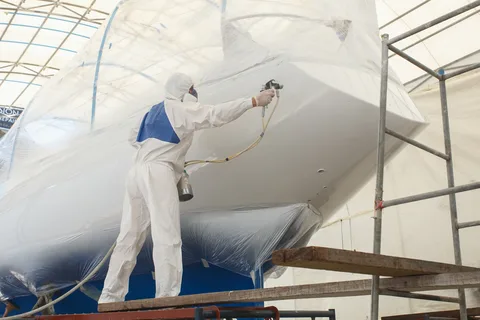In a paint booth, everything matters—down to the air you can’t see. The filter isn’t just there to catch dust; it plays a huge role in how smooth, even, and flawless a finished product turns out. When filtration is working like it should, the entire coating process gets a boost.
Filter Efficiency Directly Shapes Surface Uniformity
A clean, even paint job depends on how well the filtration system keeps the air inside the booth free of particles. If filters allow debris or dust to slip through, that contamination lands on the freshly coated surface. That’s when you start seeing tiny bumps, streaks, or uneven textures—things that ruin surface uniformity and require extra work to fix.
High-efficiency filters in an industrial paint booth trap particles before they interfere with the finish. When air is filtered thoroughly, paint flows evenly and settles smoothly. This keeps surfaces looking consistent from edge to edge. Whether it’s metal, plastic, or wood, good filtration sets the stage for a flawless finish every time.
Could Your Booth’s Filtration Be Sabotaging Final Curing Results?
Sometimes, even when the paint looks great at first, things go wrong during curing. That’s because poor filtration can affect more than just the painting step—it can throw off curing too. If filters don’t regulate airflow well, heat and air circulation inside the booth become uneven. This means one part of the product cures faster or slower than another, causing finish problems like discoloration, cracking, or peeling.
In an industrial paint booth, everything needs to work together. If the filters are clogged, outdated, or simply not suited for your specific coating process, they could be sabotaging your results without you even realizing it. Upgrading the filtration system can help maintain steady airflow and heat distribution, making sure every layer cures evenly and stays strong.
Airflow Dynamics—The Silent Influence on Paint Quality
The way air moves inside a paint booth might be invisible, but its effects are obvious on the finished product. Filters guide and shape that airflow. If it swirls the wrong way or hits surfaces too hard, it can disturb the paint before it even settles. This leads to uneven layering, sagging, or overspray that makes the coating look messy.
A well-designed filtration system in an industrial paint booth ensures air moves smoothly, top to bottom or front to back, depending on the booth’s setup. This creates a calm space where paint can do what it’s meant to—stick evenly and dry cleanly. Great airflow keeps things quiet and controlled, even when you’re spraying in high volumes.
Contamination Control Through Precision Filtration Techniques
Paint jobs are only as clean as the air inside the booth. Even tiny bits of lint, oil mist, or metal shavings can ruin a finish. Precision filtration helps control contamination by capturing these particles before they land on surfaces. It starts with choosing filters that match the booth’s workload—some jobs need basic filtration, others need multi-stage systems to trap particles of different sizes.
In an industrial paint booth where consistency matters, filters should be changed regularly and checked for performance. Filters don’t just stop debris—they help maintain the entire booth environment. Precision systems use layered filtering to block the smallest contaminants, keeping coatings clean and smooth without unexpected blemishes.
Micron-Level Filtration and Its Unseen Impact on Product Appearance
Micron-level filtration may sound technical, but it’s all about catching the tiniest particles that can mess up a finish. These particles are too small to see, but they create issues like cloudy surfaces, pitted spots, or dull patches when trapped in wet paint. In high-end industrial paint booth setups, micron-specific filters pull these invaders out of the air before they become a problem.
With tighter filtration, the appearance of each product improves dramatically. Surfaces reflect light better, colors pop, and the texture stays smooth. Even if you’re not painting luxury items, customers will notice the upgrade in quality. Micron-level filtration adds that extra polish that makes a product look professionally finished.
Why Inferior Booth Filters Cause Costly Rework
Cheap or worn-out filters seem like a small thing to skip, but they’re often the reason for expensive rework. Paint particles don’t land right, contamination ruins coats, or poor airflow causes uneven finishes—all of which mean more sanding, repainting, or even scrapping parts entirely. What could have been a quick job turns into hours of labor and wasted materials.
In an industrial paint booth, reliable filters are your first defense against doing the same job twice. When filtration falls short, it shows up in the final product, costing time, money, and customer trust. Spending a little more on quality filtration up front often saves thousands later on in rework, touch-ups, or rejected shipments.
How Upgrading Your Filtration System Can Revolutionize Coating Consistency
One of the easiest ways to improve finish results across the board is upgrading the booth’s filtration system. Better filters mean cleaner air, steadier airflow, and tighter control over contamination. That directly impacts consistency—each product looks the same, no matter the shift or operator. Upgrades can include adding pre-filters, switching to higher-grade materials, or installing automated systems to track performance.
In an industrial paint booth, even small filtration upgrades can make a big difference in results. When every part of the filtration system is fine-tuned, the whole painting process runs smoother. Less downtime, better finishes, and fewer rejects mean more productivity and better output. That’s a win for both the shop floor and the customer.
